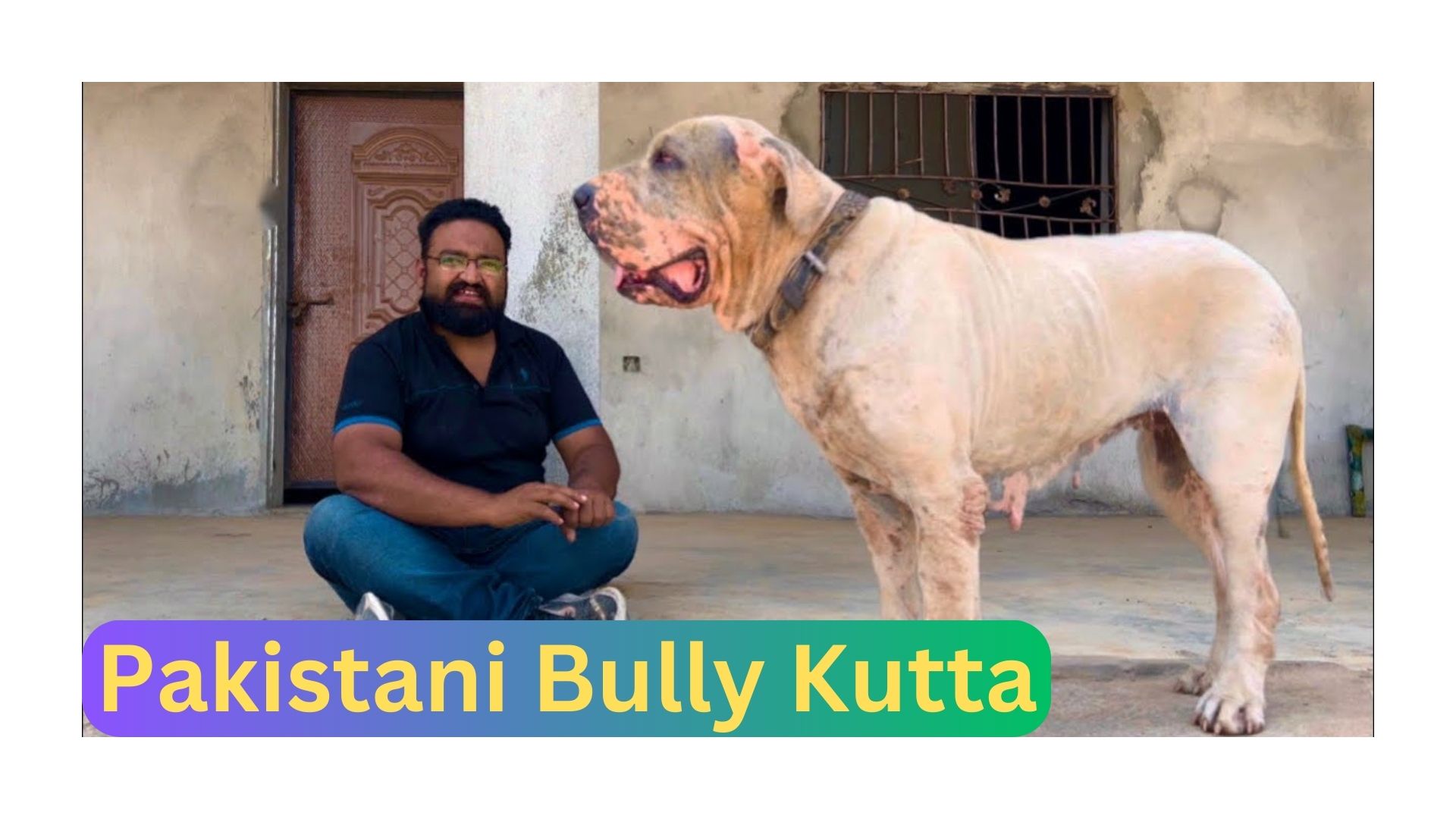The Pakistani Bully Kutta, often called the Pakistani Mastiff, is an ancient and revered breed known for its strength, loyalty, and protective nature. Originating from the Indian subcontinent, specifically Pakistan, this powerful dog breed has become a symbol of bravery and companionship. The Bully Kutta’s imposing appearance and resilient nature make it a popular choice among those seeking a guardian breed with a strong personality.
History and Origin of the Pakistani Bully Kutta
The Bully Kutta’s history dates back centuries to the Mughal era when large, powerful dogs were bred for hunting, protection, and occasionally, combat. The term “Bully” derives from the Hindi word “Bohli,” which means “heavily wrinkled,” and “Kutta,” which means “dog.” This breed became particularly popular among the nobility and rural populations who valued the dogs’ fierce loyalty and unmatched strength.
The breed’s origins are linked to the Mastiff and Alaunt breeds, which were common in Central Asia. Over time, the Bully Kutta developed distinctive features, becoming unique to the regions of Punjab, Sindh, and Balochistan in Pakistan. With generations of selective breeding, this large dog emerged as a powerful guard dog with a rich cultural heritage.
Physical Characteristics
Pakistani Bully Kuttas are known for their massive build, muscular structure, and impressive height, which can range from 28 to 36 inches at the shoulder. They are among the tallest dog breeds and can weigh between 70 and 120 kilograms (154–265 pounds).
- Coat and Color: The coat is typically short and dense, making it easier for them to endure both hot and cold climates. Common colors include white, fawn, brindle, black, and sometimes a mix.
- Head and Ears: This breed has a broad, wrinkled head with powerful jaws. Their ears are often cropped for a more intimidating appearance.
- Eyes and Expression: Their eyes are dark and intense, reflecting intelligence and alertness.
Key Physical Traits:
- Massive muscular structure
- Broad chest and powerful limbs
- Intimidating yet noble stance
Temperament and Behavior
The Bully Kutta is known for its bold and protective temperament. These dogs are naturally territorial and loyal to their families, making them excellent guard dogs. Despite their strong-willed nature, they can be affectionate and gentle with their owners. Pakistani Bully Kutta.
- Protectiveness: Bully Kuttas are highly protective of their family and property, often requiring socialization and training to control their guarding instincts.
- Intelligence: They are knowledgeable and quick learners, capable of understanding commands and reading human emotions.
- Social Needs: Though wary of strangers, they can be socialized to interact well with other pets and people. They thrive in homes where they receive proper attention and interaction.
Note: This breed is not recommended for novice dog owners. Their assertive and dominant personality requires an experienced handler who can provide firm, consistent training.
Training and Socialization
Proper training is crucial to raise a well-balanced Bully Kutta. Given their strong temperament, they require early and ongoing socialization. Here are some training guidelines for a Pakistani Bully Kutta:
- Begin Early: Start training and socialization from a young age. Introduce the puppy to a variety of people, places, and other animals.
- Positive Reinforcement: Reward-based training works well for Bully Kuttas. Avoid harsh methods, as they respond better to positive reinforcement.
- Establish Leadership: Bully Kuttas are strong-minded, so it’s essential to establish yourself as the leader. They respect authority and respond better to confident trainers.
- Consistency is Key: Consistency is essential, as Bully Kuttas need clear boundaries and regular routines.
Health and Lifespan
The Pakistani Bully Kutta is generally a hardy breed, with a lifespan of about 8-12 years. However, like all large breeds, they are prone to certain health issues.
- Hip Dysplasia: Due to their size and weight, hip dysplasia can be a concern. Regular check-ups and moderate exercise can help maintain healthy joints.
- Skin Issues: Some Bully Kuttas are prone to skin conditions, especially in humid climates.
- Obesity: This breed has a healthy appetite, so monitoring their diet is essential to prevent obesity-related health issues.
Tips for Keeping Your Bully Kutta Healthy:
- Regular vet check-ups
- A balanced diet and controlled portions
- Consistent exercise routines
Diet and Nutrition
Feeding a Bully Kutta requires careful attention to ensure they receive a balanced and nutritious diet.
- High-Quality Protein: Protein-rich diets help maintain their muscular build. Choose dog foods that list meat as the primary ingredient.
- Controlled Portions: As a large breed, overfeeding can lead to obesity. Stick to recommended portions based on their age, weight, and activity level.
- Hydration: Keeping your Bully Kutta hydrated is essential, especially in warmer climates.
- Exercise Needs
The Pakistani Bully Kutta is an energetic breed that requires ample exercise to stay physically and mentally healthy.
- Daily Walks: At least 60–90 minutes of exercise daily, including long walks and playtime.
- Mental Stimulation: Engage them in activities that challenge their minds, like obedience training, puzzle toys, or agility exercises.
- Yard Space: Ideally, they should have access to a spacious, securely fenced yard where they can roam freely.

Grooming and Care
Bully Kuttas have low grooming needs due to their short coats. However, regular maintenance is essential for overall health and hygiene. Pakistani Bully Kutta.
- Brushing: Weekly brushing helps to remove loose fur and distribute natural oils.
- Ear and Teeth Cleaning: Regularly check their ears for dirt and clean their teeth to prevent dental issues.
- Bathing: A monthly bath or as needed, depending on their activity levels and environment.
- Legal Considerations and Breed-Specific Legislation
Due to their intimidating appearance and strong guarding instincts, some regions may have specific restrictions or regulations for owning a Bully Kutta. It’s essential to check local laws regarding ownership, especially if you plan to travel with your dog.
Is the Pakistani Bully Kutta Right for You?
The Bully Kutta is an incredible breed but requires a dedicated, experienced owner who understands their needs. They make exceptional guard dogs and are loyal family companions, but they demand attention, training, and socialization.
Who Would Benefit Most from Owning a Bully Kutta?
- Individuals with experience handling strong, large breeds
- Those seeking a loyal guard dog
- Owners who can dedicate time to training and socializing
Conclusion
The Pakistani Bully Kutta is a majestic and powerful breed, rooted in history and admired for its loyalty and strength. For those who can handle the breed’s unique needs and assertive personality, the Bully Kutta offers unparalleled companionship and protection. However, this breed requires responsible ownership and a commitment to training and care. Pakistani Bully Kutta.
Owning a Bully Kutta is not for everyone, but those who respect this breed’s characteristics will find a faithful, devoted friend. With the right environment, training, and care, the Pakistani Bully Kutta stands as a remarkable guardian and a true testament to the enduring bond between humans and dogs.
Pakistani Bully Kutta FAQs
Q1: What is a Pakistani Bully Kutta?

A: The Pakistani Bully Kutta also known as the Pakistani Mastiff, is a large, powerful breed originating from Pakistan and parts of India. Known for its strength, loyalty, and imposing presence, it’s often used as a guard dog due to its natural protective instincts.
Q2: Are Pakistani Bully Kutta aggressive?
A: Bully Kutta can exhibit aggressive behavior, especially toward strangers or other animals, due to their strong guarding instincts. However, with proper training and early socialization, they can become well-balanced, loyal pets. They require an experienced handler who can provide firm, consistent training.
Q3: How big do Pakistani Bully Kuttas get?
A: Bully Kuttas are very large dogs, standing between 28 to 36 inches at the shoulder and weighing between 70 to 120 kg (154–265 lbs). Their powerful, muscular build makes them one of the most imposing dog breeds.
Q4: Are Bully Kuttas good family pets?
A: With proper training and socialization, Bully Kuttas can be loyal and protective family members. However, they may not be ideal for families with small children due to their size and strength. This breed is best suited for families with experience in handling strong, large dogs.
Q5: What is the lifespan of a Pakistani Bully Kutta?
A: The average lifespan of a Pakistani Bully Kutta is around 8–12 years, depending on factors such as genetics, diet, and health car
Q6: Do Bully Kuttas require a lot of exercise?
A: Yes, Bully Kuttas are an active breed that requires at least 60–90 minutes of daily exercise. They enjoy long walks, runs, and activities that challenge them both physically and mentally. A large, secure yard is ideal for them to roam freely.
Q7: How much grooming does a Pakistani Bully Kutta need?
A: The Bully Kutta has a short coat, so it requires minimal grooming. Weekly brushing is sufficient to keep their coat clean, along with regular ear and dental care. They generally need a bath once a month or as needed.
Q8: What type of diet is best for a Bully Kutta?
A: A high-protein diet is recommended to support the Bully Kutta muscular build. Quality dog food that lists meat as the primary ingredient is ideal. Avoid overfeeding, as this breed is prone to obesity if not exercised regularly.
Q9: Are Pakistani Bully Kuttas prone to health issues?
A: Like many large breeds, Bully Kuttas are susceptible to hip dysplasia and obesity if not monitored closely. Regular vet check-ups, a balanced diet, and consistent exercise can help keep them healthy..
Q10: Is the Pakistani Bully Kutta banned in some areas?
A: Due to its reputation as a guard dog and its intimidating size, some regions may have restrictions or specific regulations for owning a Bully Kutta. It’s essential to check local laws, especially if you’re considering owning or traveling with this breed.
